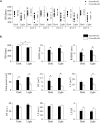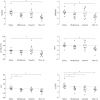Age-Related Changes in Cardiac Autonomic Modulation and Heart Rate Variability in Mice
- PMID: 34084126
- PMCID: PMC8168539
- DOI: 10.3389/fnins.2021.617698
Age-Related Changes in Cardiac Autonomic Modulation and Heart Rate Variability in Mice
Abstract
Objective: The aim of this study was to assess age-related changes in cardiac autonomic modulation and heart rate variability (HRV) and their association with spontaneous and pharmacologically induced vulnerability to cardiac arrhythmias, to verify the translational relevance of mouse models for further in-depth evaluation of the link between autonomic changes and increased arrhythmic risk with advancing age.
Methods: Heart rate (HR) and time- and frequency-domain indexes of HRV were calculated from Electrocardiogram (ECG) recordings in two groups of conscious mice of different ages (4 and 19 months old) (i) during daily undisturbed conditions, (ii) following peripheral β-adrenergic (atenolol), muscarinic (methylscopolamine), and β-adrenergic + muscarinic blockades, and (iii) following β-adrenergic (isoprenaline) stimulation. Vulnerability to arrhythmias was evaluated during daily undisturbed conditions and following β-adrenergic stimulation.
Results: HRV analysis and HR responses to autonomic blockades revealed that 19-month-old mice had a lower vagal modulation of cardiac function compared with 4-month-old mice. This age-related autonomic effect was not reflected in changes in HR, since intrinsic HR was lower in 19-month-old compared with 4-month-old mice. Both time- and frequency-domain HRV indexes were reduced following muscarinic, but not β-adrenergic blockade in younger mice, and to a lesser extent in older mice, suggesting that HRV is largely modulated by vagal tone in mice. Finally, 19-month-old mice showed a larger vulnerability to both spontaneous and isoprenaline-induced arrhythmias.
Conclusion: The present study combines HRV analysis and selective pharmacological autonomic blockades to document an age-related impairment in cardiac vagal modulation in mice which is consistent with the human condition. Given their short life span, mice could be further exploited as an aged model for studying the trajectory of vagal decline with advancing age using HRV measures, and the mechanisms underlying its association with proarrhythmic remodeling of the senescent heart.
Keywords: aging; arrhythmias (cardiac); autonomic cardiac modulation; heart rate variability (HRV); mouse model.
Copyright © 2021 Piantoni, Carnevali, Molla, Barbuti, DiFrancesco, Bucchi and Baruscotti.
Conflict of interest statement
The authors declare that the research was conducted in the absence of any commercial or financial relationships that could be construed as a potential conflict of interest.
Figures





References
-
- Antelmi I., de Paula R. S., Shinzato A. R., Peres C. A., Mansur A. J., Grupi C. J. (2004). Influence of age, gender, body mass index, and functional capacity on heart rate variability in a cohort of subjects without heart disease. Am. J. Cardiol. 93 381–385. 10.1016/j.amjcard.2003.09.065 - DOI - PubMed
-
- Axsom J. E., Nanavati A. P., Rutishauser C. A., Bonin J. E., Moen J. M., Lakatta E. G. (2020). Acclimation to a thermoneutral environment abolishes age-associated alterations in heart rate and heart rate variability in conscious, unrestrained mice. Geroscience 42 217–232. 10.1007/s11357-019-00126-7 - DOI - PMC - PubMed

